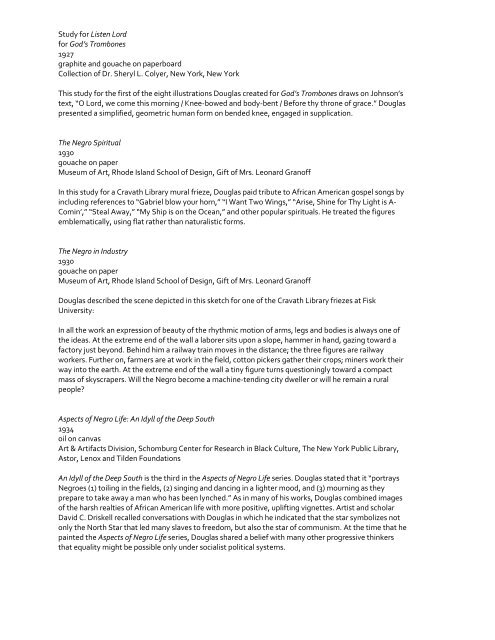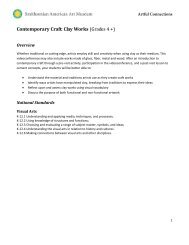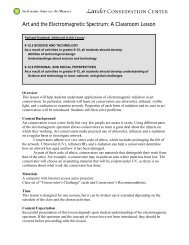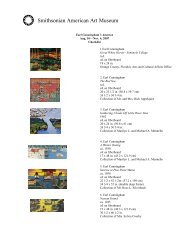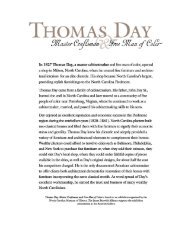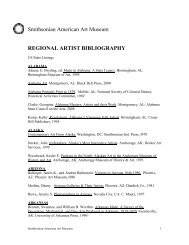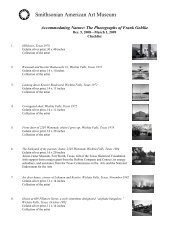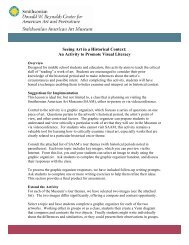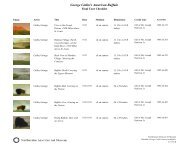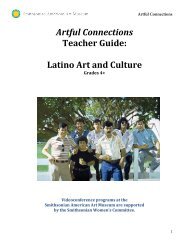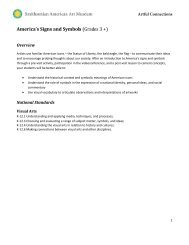Smithsonian American Art Museum Wall Text & Extended Labels
Smithsonian American Art Museum Wall Text & Extended Labels
Smithsonian American Art Museum Wall Text & Extended Labels
Create successful ePaper yourself
Turn your PDF publications into a flip-book with our unique Google optimized e-Paper software.
Study for Listen Lord<br />
for God’s Trombones<br />
1927<br />
graphite and gouache on paperboard<br />
Collection of Dr. Sheryl L. Colyer, New York, New York<br />
This study for the first of the eight illustrations Douglas created for God’s Trombones draws on Johnson’s<br />
text, “O Lord, we come this morning / Knee‐bowed and body‐bent / Before thy throne of grace.” Douglas<br />
presented a simplified, geometric human form on bended knee, engaged in supplication.<br />
The Negro Spiritual<br />
1930<br />
gouache on paper<br />
<strong>Museum</strong> of <strong>Art</strong>, Rhode Island School of Design, Gift of Mrs. Leonard Granoff<br />
In this study for a Cravath Library mural frieze, Douglas paid tribute to African <strong>American</strong> gospel songs by<br />
including references to “Gabriel blow your horn,” “I Want Two Wings,” “Arise, Shine for Thy Light is A‐<br />
Comin’,” “Steal Away,” “My Ship is on the Ocean,” and other popular spirituals. He treated the figures<br />
emblematically, using flat rather than naturalistic forms.<br />
The Negro in Industry<br />
1930<br />
gouache on paper<br />
<strong>Museum</strong> of <strong>Art</strong>, Rhode Island School of Design, Gift of Mrs. Leonard Granoff<br />
Douglas described the scene depicted in this sketch for one of the Cravath Library friezes at Fisk<br />
University:<br />
In all the work an expression of beauty of the rhythmic motion of arms, legs and bodies is always one of<br />
the ideas. At the extreme end of the wall a laborer sits upon a slope, hammer in hand, gazing toward a<br />
factory just beyond. Behind him a railway train moves in the distance; the three figures are railway<br />
workers. Further on, farmers are at work in the field, cotton pickers gather their crops; miners work their<br />
way into the earth. At the extreme end of the wall a tiny figure turns questioningly toward a compact<br />
mass of skyscrapers. Will the Negro become a machine‐tending city dweller or will he remain a rural<br />
people?<br />
Aspects of Negro Life: An Idyll of the Deep South<br />
1934<br />
oil on canvas<br />
<strong>Art</strong> & <strong>Art</strong>ifacts Division, Schomburg Center for Research in Black Culture, The New York Public Library,<br />
Astor, Lenox and Tilden Foundations<br />
An Idyll of the Deep South is the third in the Aspects of Negro Life series. Douglas stated that it “portrays<br />
Negroes (1) toiling in the fields, (2) singing and dancing in a lighter mood, and (3) mourning as they<br />
prepare to take away a man who has been lynched.” As in many of his works, Douglas combined images<br />
of the harsh realties of African <strong>American</strong> life with more positive, uplifting vignettes. <strong>Art</strong>ist and scholar<br />
David C. Driskell recalled conversations with Douglas in which he indicated that the star symbolizes not<br />
only the North Star that led many slaves to freedom, but also the star of communism. At the time that he<br />
painted the Aspects of Negro Life series, Douglas shared a belief with many other progressive thinkers<br />
that equality might be possible only under socialist political systems.


